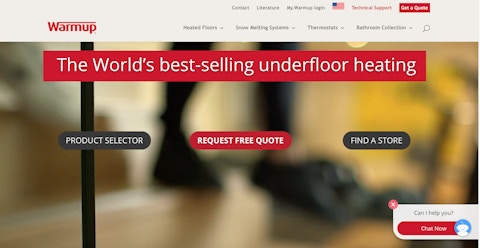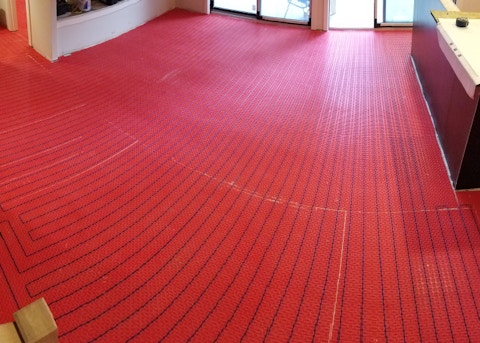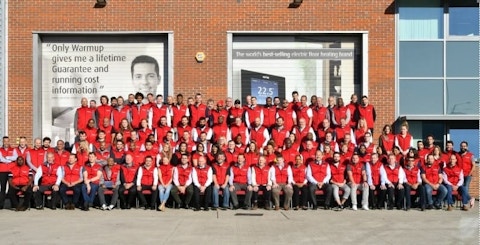More About This Show
The Smarter Building Materials Marketing podcast helps industry professionals find better ways to grow leads, sales and outperform the competition. It’s designed to give insight on how to create a results-driven digital marketing strategy for companies of any size.
In this episode, Zach and Beth talk to Regis Verliefde, CEO at Warmup, about how his company’s mantra of “fail often and fast” has driven incredible growth and success.
Gaining Efficiency With Chatbots

The story of Warmup’s marketing successes is a story of trial and error. Originally based in the UK, Warmup offers underfloor heating systems. With over 67% of North American homes choosing forced air heating for their homes, breaking into the home heating market can be challenging for other systems, despite being widely adopted in Europe and other regions.
The first thing that comes to mind for Zach and Beth when it comes to Warmup’s marketing efforts is their online chatbot. Beth says, “We actually refer people to go look at your chatbot a lot when they ask how manufacturers can implement a chatbot on their website.”
The automated attendant is available as soon as you open the website but only offers help when asked, using a series of pre-programmed questions to help potential customers get the information they’re looking for.
"63% of people do not want to call you. They do not want to talk to you."
While automated chatbots may feel impersonal, Regis says they are the way most online consumer communication will be going in the future. “The data out there is very clear. 63% of people do not want to call you. They do not want to talk to you. They would love to get the information online right there and then.”
Giving people access to a resource who will answer their questions immediately not only helps meet customer expectations, it uses the Warmup team’s talents better.
“When I hear them [the team] answer a silly tech call or help people program their thermostat for a half-hour, I think to myself, they don't want to do it. The people on the phone don't want to be on the phone doing it. How can we make this better?”
Why Even Failures Provide Good Data

But “better” didn’t happen overnight. While Warmup’s chatbot is pretty sophisticated now, Regis admits there was a steep learning curve. “To be honest, there weren't a whole lot of questions we could answer with the bot in its original form.”
Initially, they measured the success of their bot through engagement, rather than through conversions or sales. “What we wanted is for people to engage with it, to click on it to see what they were after. Why are they on this website?”
By the time they had over 250 people a day engaging with the bot, the team had some very solid data, not only about what potential customers were looking for, but how they wanted to be engaged with. Regis’s team measured engagement, whether people seemed to realize they were talking with a computer, and whether or not the bot was able to successfully answer their question.
“All of that became data. And so all of that quickly allowed us to see, did we have the wording right?” The bot will typically offer multiple answers to a question to help guide users to the information they want, but if the right answer isn’t provided among the options, users drop out and the lead is lost. By monitoring length of use and overall success, Warmup could refine the bot’s development.
Beth says, “I love the way of approaching it of ‘everything is data.’ That you knew you weren't going to get it right, right out of the gate, but what we are going to do is learn how to get it right. I just think that's the exact right way to approach that.”
Regis feels that most North American customers are fairly forgiving. “They don't mind a beta version: They don't mind earlier but not perfect. And as long as you don't completely screw it up, as long as you don't put your most precious asset out front and fail.”
When Change Means Going Back to Basics

Zach really appreciates the underlying philosophy to Regis’s approach. “What I like about what you're saying is when we build a website or help with digital marketing or something like that, we're always thinking about things from the user's perspective. Who is actually visiting my site and what are the problems that they're running into?”
This customer-centric approach to content is especially highlighted in a website overhaul that Warmup took on a few years ago. At the time, the marketing team was managing 30 sites around the globe, which became a very time-consuming and tedious task as they struggled to manage optimization and pay-per-click campaigns.
“At some point we said, let's just think about who we're talking to and write it like these people are face-to-face and just go with that.”
Even faced with all the data and best practices about SEO, Regis decided to take a step back and really consider user behavior and needs and what would resonate most with the people looking for information on the Warmup website.
“At some point, you got to set technology aside, the benchmarking aside."
“At some point, you got to set technology aside, the benchmarking aside. You just got to go into a dark room and think about what does this thing really need to do? What do you want from your website? Ultimately, you want a lot of people visiting it and engaging with it and having conversions, whatever the conversions are.”
The beauty of that simple question is that Warmup already had nearly real-time insights into what their customers were actively looking for, thanks to their bot. With over 250 interactions a day, it was easy to pinpoint what the most pressing questions were and which conversations customers were hoping to have when they arrived on the Warmup website.
This data is something that many manufacturers either don’t have or don’t look at. Beth says, “I think the question of why have a website would be a really tricky question for a lot of manufacturers to answer, without it being all about them.”
How to Embrace Failure

Answering the question of “why do we have a website?” at Warmup was not easy. Regis says, “It does take people aback because they're so deep into the technical aspect, especially people who are SEO specialists. They have every metric in the book, and they're there in Google Analytics all day long. Asking them why we have a website is a tough question.”
Pausing SEO campaigns in favor of a simpler approach could feel risky to many marketing directors and CEOs. Beth wants to explore that more.
“You make space for failure and you've created a culture that embraces it in a way that allows you to learn quickly. So I imagine your people felt safe to pause, what we would call traditional SEO, for the sake of trying this other thing where we just focus on what people need from us. Can you talk to us a little bit about how you guys make failure safe?”
Warmup’s gospel is “fail often and fast.” As Regis puts it, “We want to ask tough questions while respecting each other so that we can try new things. Some of it sticks, some of it doesn't.”
Regardless of the initiative, their approach is to use a minimum viable product, or MVP, to test the concept before making wholesale changes.
“As soon as you have something basic, do people engage with it? When we went from a website that was all about SEO optimization to a website that was ‘Let's tell my mom about heated floors,’ we applied that principle and said, ‘Okay, let's not change the whole website.’”
Rather than overhauling the entire website, they updated their homepage and the pages targeting homeowners. Based on that, they were able to measure engagement and conversions, which they could then use to justify larger changes.
“The metrics were significantly improving and so we improved the rest of the website bit-by-bit. And that was that ‘fail often and fast’ principle in motion.”
Why Getting Lucky Is Great...But Isn’t Enough

Regis says it’s easy to romanticize a culture of failure when you can point to successes, but it would be disingenuous to ignore the actual failures, too. He cites an example where he and his team had swag designed to give away to contractors, and the whole campaign crashed and burned because no one had bothered to consult contractors about what they wanted.
“When the contractors saw it, they said ‘What is this for? Not for me. I'm not wearing that.’”
"You can't get lucky if you stay bundled up in your house.”
So not every idea is a winner, and not every success comes from a concerted strategic campaign. Sometimes luck plays a role. “The story of Warmupedia is one where I did get a little lucky, but you can't get lucky if you stay bundled up in your house.”
Warmupedia is Warump’s online technical resource site. It includes documents on installation, troubleshooting and user manuals for all of Warmup’s products.
Warmupedia started out as a training tool. “Every time we had a new person we had to train this person and we thought, well why don't we write it down? We'll give Joe 10, 20, 30 pages of things to read and then we'll continue training them.”
As the company continued to grow and migrate more of its documents into shared Cloud and other online locations, the decision was made to put Warmupedia on a Wordpress site. It was still intended to be an internal resource, but using Wordpress made it publicly available.
“Next thing you know, this thing is blowing out of proportion. It is ugly as hell. It doesn't have any editing and we have 20 or 30,000 people a year going to it.” The marketing team went to work making it something both useful and appealing, as well as easy to navigate, and the numbers continue to speak for themselves.
“Now, we get about 75 to 100,000 people going on that website. Just like the bot, 63% of people want to find the answer on Warmupedia. They don't want to talk to us. So it's really doing that now. Our team doesn't spend a lot of time answering lengthy repetitive questions. They can either send you a link or you've already found out on the website.”
Warmupedia’s origin story is a little bit about luck, but it’s also about seizing opportunity, even if the intention wasn’t there to begin with. Warmup could have kept the documentation off the public web, or pulled the Warmupedia content when they realized the public was accessing it. Instead, it has grown to be such a valuable resource that some of its pages have a zero listing on Google.
How to Adopt a Culture of Failure

Before the interview wraps up, Zach wants to know if Regis has any advice, particularly for manufacturers struggling to embrace failure.
The answer is both simple and difficult. “The important thing is to have mutual respect for each other. if you have great respect for the people you hire and if you hired smart people, let them do what you hired them for. Give them the right mission, but respect their view, you actually give them that freedom to succeed.”
Embracing failure is, in part, about acting quickly. Coming to a decision and testing out that MVP. Regis says it’s very easy to overthink a problem, or over-design a solution, and come up with a complete response in isolation, without ever testing whether or not it’s actually what customers want.
“At some point, you get to stop and think — and I'll go back to the website story — the thinking in isolation means at some point, stop listening to SEO. Stop listening to all the metrics. Yes, they're out there. Put a towel over your head and think, ‘Why do I have a website? And what is it supposed to say? What do people want it to say?’”
He says most attempts and failures, especially if they’re backed by smart, intelligent people, are very unlikely to hurt your brand.
“It's actually going to give you shortcuts to the end result. What happens is you plan this product and it's going to do this and this and this, and if you wait for that point for people to tell you, ‘Oh, but you know, we don't use those screws because we don't have those bits in our drills,’ you're going to have to do a lot of backpedaling at a very late product launch stage. It's much better to develop publicly.”
Got a Question?
If you have questions about embracing failure can drive growth in your organization, let us know! Shoot us an email at [email protected] with all of your questions.








